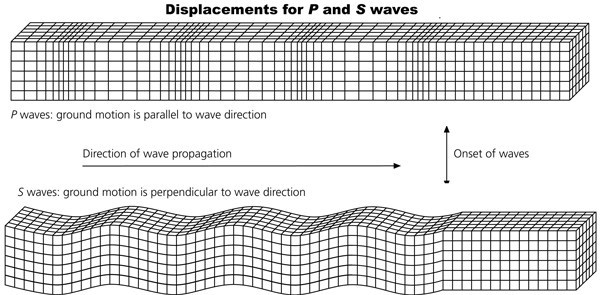Earthquake is the sudden and temporary vibration set up on the earth surface caused by the released seismic waves from the earth's interior on it's surface.Seismic waves are the enormous waves released from the focus at the time of earthquake is transmitted in all direction in the form of waves.Seismic waves are of following types;
Body waves,
Surface waves.
Body Waves:
These are the waves which pass through the interior of the earth.These are of two types:
P waves:
These are called Primary Wave or Longitudinal Waves or Compression Waves, like Sound wave.It shakes things in the same direction it travels.The P wave can travel through solid, semi-solid and liquid i.e, crust, mantle and core.
S Waves:
These are the secondary waves and also known as transverse or shear waves. An S wave is slower tha....Show More
Earthquake is the sudden and temporary vibration set up on the earth surface caused by the released seismic waves from the earth's interior on it's surface.Seismic waves are the enormous waves released from the focus at the time of earthquake is transmitted in all direction in the form of waves.Seismic waves are of following types;
Body waves,
Surface waves.
Body Waves:
These are the waves which pass through the interior of the earth.These are of two types:
P waves:
These are called Primary Wave or Longitudinal Waves or Compression Waves, like Sound wave.It shakes things in the same direction it travels.The P wave can travel through solid, semi-solid and liquid i.e, crust, mantle and core.
S Waves:
These are the secondary waves and also known as transverse or shear waves. An S wave is slower than P wave and can only move through solid rocks. This wave moves rock up and down, or side-to-side i.e, rock vibrates perpendicular to the direction of wave propagation and much more destructive than P waves. Velocity of P wave is 1.7 times that of S wave.
Surface Waves:
Surface waves, in contrast to body waves can only move along the surface. They arrive after the main P and S waves and are confined to the outer layers of the Earth. They cause the most surface destruction. Earthquake surface waves are divided into two different categories:
Rayleigh Wave:
Rayleigh waves, also known as ground roll, spread through the ground as ripples, similar to rolling waves on the ocean. Like rolling ocean waves, Rayleigh waves move both vertically and horizontally in a vertical plane pointed in the direction in which the waves are travelling.Rayleigh waves are slower than body waves and typically travel at a speed that is 10% slower than S-waves.
Love Wave:
Love waves have the same motion as S-waves but without the vertical displacement. They move the ground from side to side in a horizontal plane but at right angles to the direction of propagation. Love waves are particularly damaging to the foundations of structures because of the horizontal ground motion they generate. Love waves can also cause horizontal shearing of the ground. They usually travel slightly faster than Rayleigh waves, at a speed that is usually about 10% slower than S-waves, but like S-waves, they cannot spread through water.
sno.
| Body Waves
| Surface Waves
|
1
| They arrive before surface waves are emitted by an earthquake.
| These waves are generated due to the effect of Body waves on earth surface
|
2
| They are of higher frequency than surface waves.
| They are of lower frequency than body waves.
|
Causes Of Earthquake:
Tectonic Causes
Non tectonic causes
Tectonic Causes:
Earthquake is caused by faulting and folding in the crust due to tectonic activities.The mechanism of earthquake is well defined by the Elastic Rebound Theory.The earth is a dynamic body,the plates on the earth are moving continuously,due to which the rocks, at the plate boundaries, are continuously undergoing deformation. During the process of deformation of a plate, a great amount of stress is gradually exerted on the rock. When the stress exceeds the elastic limit, a fracture is developed.But the friction along the fracture resist the movement for certain time, when the stress exceeds the frictional resistance also, the block moves along a fault plane i.e, an accumulated energy is suddenly released and it travels through the earth shaking the earth's crust for a period of time.This concept of earthquake is called 'Elastic Rebound Theory'.
Non tectonic causes:
The earthquake may also occur due to collapse of subterrain cavaties and underground mines. The ground may shake due to large scale blasting and use of heavy machines as well as passing trains and tanks.Big landslides and avalanches are also responsible for ground tremor. Other reason may be the volcanic eruption and collapse of volcanic terrain.
Civil Engineering Consideration in Seismic Areas:
Seismic areas are the place which experience earthquake frequently. The civil engineers must think of making his construction immune to earthquakes. The difficulties in achieving this objectives are:
the exact place of earthquake (this is important because the epicenter region will be worst affected and hence needs maximum protection).
the magnitude of earthquake (this is important because the cost of construction increases with increases in safety required).
the duration of earthquake (this is important because the extent of damage will be more if duration is more).
the direction of movement of the ground at the time of earthquake.
The above mentioned factors are crucial because unless they are known, assessment of probable damage due to earthquake to civil engineering structures is not possible.
 Guest
Guest
